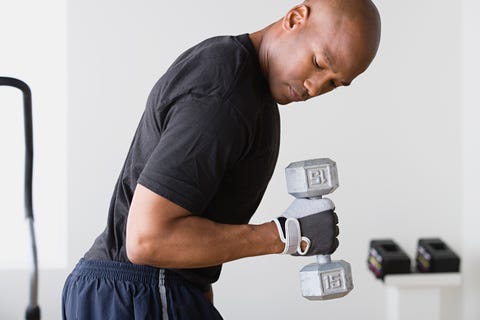How to Get Rid of Calluses on Hands
When you first start lifting weights, you'll probably notice quite a few new physical side-effects right off the bat: muscle growth, a shift in your metabolism, and — if you're working hard with iron dumbbells and barbells — newly rough and callused palms.
The skin on your hands is getting stronger along with your muscles, as anyone who has ever learned barbell-centric Olympic lifts can attest. The tough, conditioned calluses might not be as appealing to some as silky smooth palms, but for others they serve as an obvious testament to the hours you've spent working hard in the weight room. Your handshake is now even stronger with the rugged ridges, along with your newly-honed grip strength.
But calluses have some practical disadvantages, too. Whether you consider them brag-worthy battle scars or just a pesky side effect of your new weight lifting routine, calluses can cramp your style, not to mention disrupt your workouts.
"Calluses symbolize hard work, but they can be a real issue for someone new to lifting," Mark Hofman, a StrongFirst-certified kettlebell instructor and owner of SolFire Fitness in Albuquerque, New Mexico, told MensHealth.com.
If you're a dedicated lifter doing exercises like snatches and cleans, calluses are inevitable. Here's how to treat them.
Never, Ever Wear Gloves
They might save your hands, but any gear meant to prevent calluses will sabotage your workout, too.
"Gloves hinder proper technique, especially with kettlebells," Hofman said. "Your lifts can be stronger without them."

Rob Lewine Getty Images
Gloves can also make it easier to grip the bar in some instances, which takes an important element out of your lift. In other scenarios, like when you perform explosive movements like a clean, you might not be able to get as firm of a handle on the bar, making it more difficult to control the weight. Either way, veteran lifters can always spot a novice (or someone who doesn't exactly know what they're doing) if they're wearing gloves. Wrist wraps or straps are acceptable, and, like weight belts, are sometimes essential for heavy lifts where grip strength just isn't enough — but you shouldn't make gloves part of your ever day weight room getup.
But you can reduce friction another way: by chalking up your hands before your start your exercise. Just don't be that guy who uses too much and leaves behind clouds of white dust on the gym floor.
Never Pick Them
It might be tempting. Your calluses might even come off easily, but resist the temptation to pull at them — you'll only make the problem worse.
"Pulling, stretching, and picking at calluses basically tells your body to make them thicker and tougher," Dr. Tyler Hollmig, MD, a dermatologist at Stanford, told MensHealth.com.
Not to mention you could cause them to bleed, in which case you should treat them immediately. Trying to power through cuts and rips will only hurt your grip strength more — you'll never be able to hit that power clean PR if the open wounds on your hands are bleeding through the lift. Bandage your hands properly and don't hit the weights without taping up your rips.
"Some folks may think it's 'cool' or 'tough' to power though broken calluses," said Hofman. "But no one wants to see you bleed all over equipment they might need to use next."
Use the Right Tools
Luckily, reducing calluses is much easier than the reps it took to create them.
Start by soaking rough areas in warm water for 15 to 30 minutes — add epsom salts for better results.
Once soft, shave off dead skin using a pumice stone or microplane (a gentle grater designed for skin), working gently to avoid going too deep or cutting yourself.
Once the calluses are worn down, apply a rich lotion to keep it hydrated.
Corn Huskers Lotion is a popular moisturizer for lifters, but if you want enhanced results, use one that contains the chemical exfoliants urea or ammonium lactate, says Dr. Hollmig.
He recommends you try CeraVe SA Renewing Skin Lotion, which can help to make your hands less leathery.

CeraVe SA Renewing Lotion 8 oz
CeraVe amazon.com
"Put it on right after a shower—up to twice a day—to significantly reduce roughness," Hollmig advised.
Just know the results won't be instant, just like your weight lifting gains. Once you start moisturizing, you should notice a difference after about two weeks.
This content is created and maintained by a third party, and imported onto this page to help users provide their email addresses. You may be able to find more information about this and similar content at piano.io
How to Get Rid of Calluses on Hands
Source: https://www.menshealth.com/fitness/a19547550/how-to-treat-calluses-from-lifting/